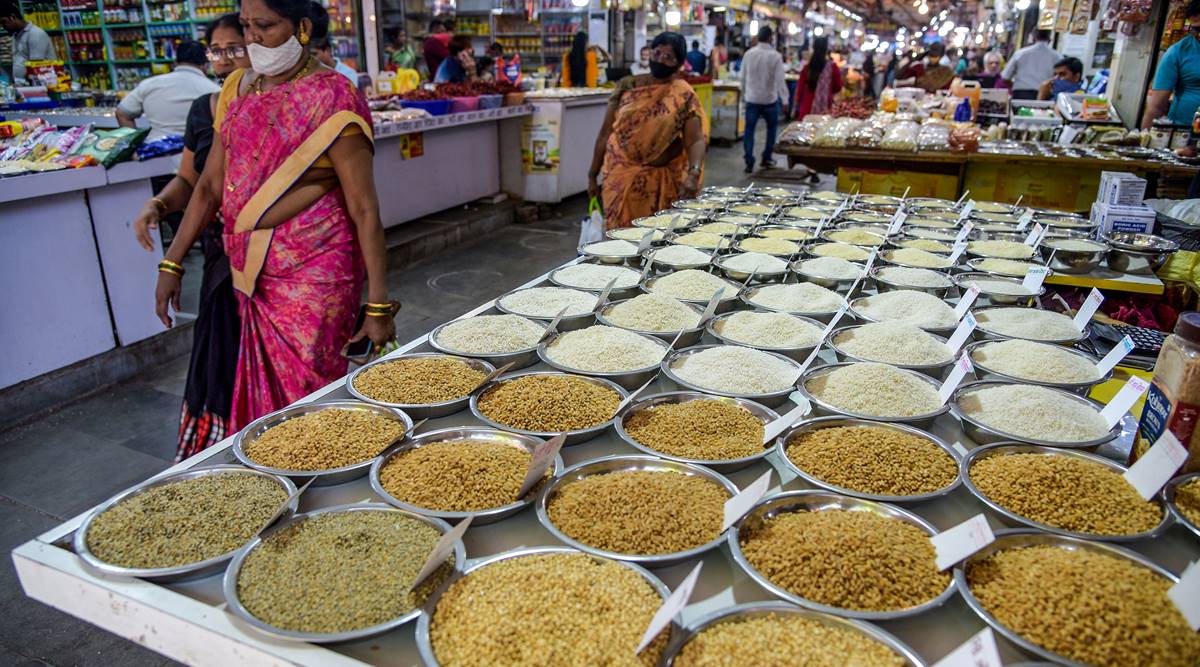Updated: May 16, 2022 8:10:49 am
 Customers at the grain market, on the day of presentation of the Union Budget 2022-23, in Navi Mumbai. (PTI Photo)
Customers at the grain market, on the day of presentation of the Union Budget 2022-23, in Navi Mumbai. (PTI Photo)Roti (wheat) is becoming dearer on the back of soaring global prices and a heat wave-affected domestic crop — but that isn’t the case with dal (pulses), whose retail prices are lower than a year ago despite the rising food inflation.
One major reason for this, according to dal millers and traders, is the fear of a government crackdown on any activity remotely suggestive of speculative hoarding. They specifically cite an order issued last July by the Department of Consumer Affairs (DCA), that imposed stock-holding limits on all pulses, barring moong (green gram).
This, ironically, came after the Union government enacted the Essential Commodities (Amendment) Act, one of the three farm reform laws, in September 2020.
“It was totally unexpected and had a chilling effect on the trade. Nobody wants to take a chance after that,” said a leading pulses trader in Indore.
Best of Express Premium
The July 2 order imposed stock limits (“on all pulses put together, except moong”) of 200 tonnes for wholesalers, 5 tonnes for retailers, and last three months’ production or 25% of annual installed capacity (whichever was higher) for millers.
On July 19, these limits were raised to 500 tonnes for wholesalers and last six months’ production or 50 per cent of annual installed capacity (whichever was higher) for millers. Further, importers were exempted from any limits, but had to mandatorily declare their stocks of pulses on the DCA’s portal.
“The stock limits were effective till October 31 and allowed to lapse. Also, harvesting and market arrivals of the kharif (post-monsoon) pulses crop had begun,” the trader pointed out. But there is no guarantee that they will not be re-imposed. “The limits were imposed in July 2021, when the farm laws were still there, despite being stayed by the Supreme Court. The actual repeal happened only in November 2021. Today, the laws themselves don’t exist and there’s nothing even on paper stopping the government from bringing back stock limits,” he added.
Speculative trade normally takes place when production is low and traders start accumulating stocks, sensing opportunities from price rise in the months ahead. There were enough opportunities this time because of a not-too-great kharif crop. An extended dry spell in July affected both moong and urad (black gram) production. In tur/arhar (pigeon-pea), the damage was caused by excess rain around the time of harvest.
But fear of punitive action meant nobody even attempted to play up the market.
This is borne out by data from the DCA. The all-India average modal (most-quoted) retail price of chana dal was Rs 70 per kg on Friday, as against Rs 75 one year back. Prices have similarly fallen for tur (from Rs 110 to Rs 98.5), urad (Rs 107.5 to Rs 98) and moong (Rs 105 to Rs 95), while rising only for masur or red lentil (Rs 82 to Rs 92.5).
Nitin Kalantari, a dal mill owner and trader from Latur in Maharashtra, also attributed the low, if not negative, inflation in pulses to the Union government’s liberal import policy. The total effective duty on masur imported from Canada and Australia was cut from 33 per cent to 11 per cent on July 26 — and to nil on February 12.
The government, on March 29, also announced it would allow imports of tur and urad dal at zero duty till March 31, 2023.
Free imports, coupled with a lurking fear of government re-imposing stock limits at any time, have at least ensured that there is little to no inflation in dal — even if not roti.
- The Indian Express website has been rated GREEN for its credibility and trustworthiness by Newsguard, a global service that rates news sources for their journalistic standards.

